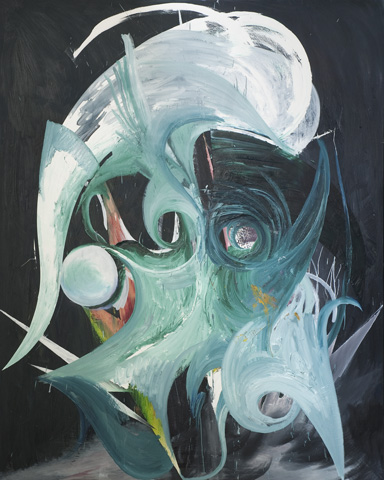
Kassierer - Malerei, Zeichnung, Plastik
STUTTGART: 6. Juni - 30. Juli 2011
In den Bildern und Skulpturen Sebastian Gögels verliert die konkrete äußere Welt an Faszination gegenüber der Welt des Subjekts. Die Wahrheit des Subjekts hat immer den Charakter einer Fiktion. Sie ist eine symbolische Konstruktion aus heterogenen Elementen, in der sich Zeugnisse, Zitate und Deutungen des Subjekts mischen. Damit ist die Fiktion jedoch keine bloß „subjektive“ oder „relative“ Wahrheit, sondern sie ist in erster Linie ein Wirken.
Die ambivalente Wirkmacht von Albträumen, Visionen, oftmals des Grauens, verspricht ein poetisches Potential zwischen Angst und Lust, das die Kunst seit jeher beflügelt. Anhand der „Kunstgeschichte des Grauens“ lässt sich feststellen, dass auch diese andere traumatische Welt jenseits der Grenze einer Ordnung unterworfen ist. Diese „Ordnung des Unbewussten“ in der Kunst ist durch Stilmerkmale gekennzeichnet, die mit dem Begriff des Formlosen (Bois/Krauss) verbunden sind. Gemeint ist hierbei nicht die Negation der Form, sondern vielmehr die Bewegung ihrer Auflösung, der Prozess der Überschreitung oder Penetration von Körpergrenzen.
Dass Sebastian Gögel seine phantasmagorischen, amorphen Zeichnungen und Gemälde mitunter auch auf menschliche Haut tätowiert, entspricht einer Geste der Grenzüberschreitung, die sich durch seine medienübergreifende Arbeit zieht. In seinen stark deckenden Farben und schwer tropfenden oder quellenden Formen scheint stets eine unterdrückte Kraft gegen einen Widerstand zu kämpfen, die mal explosiv, mal triefend zum Ausbruch kommt. Es formieren sich so Gestalten einer surrealen Welt, in denen Angst, Beklemmung und Gewalt – das gesamte Spektrum des Unbehagens in der Kultur – zum Ausdruck kommen und die Stabilität des Subjekts erschüttern.
Text: Galerie Parrotta Contemporary Art.
Sebastian Gögel »Kassierer« (Engl.)
Painting, Drawing, Sculpture
In the pictures and sculptures by Sebastian Gögel, the concrete external world loses its fascination in comparison with the world of the subject. The subject’s truth always bears the character of fiction. It is a symbolic construction out of heterogeneous elements in which evidence, quotes and interpretations of the subject interfuse. In this way, fiction is not solely a “subjective” or “relative” truth but first and foremost an effective force.
The ambivalent effect caused by nightmares, visions, and often horror promises a poetic potential between angst and lust that has been firing art since the early days. On the basis of the “Art History of Horror” one can establish that this other traumatic world beyond borders is subject to an order. Within art, this “Order of the Subconscious” is marked by characteristics of style which are connected to the term of the formless (Bois/Krauss). Here, this does not mean negation of the form but rather the notion of its dissolution, the process of exceeding or penetrating the boundaries of the body.
The fact that Sebastian Gögel at times tattoos his phantasmagorical, amorphous drawings and paintings on human skin complies with a gesture of transgression – a recurrent theme in his intermedia work. A restraint force seems to constantly fight against a form of resistance, which can disrupt in an explosive or oozing way through his intensely opaque colours and strongly dripping or expanding forms. Thus, figures of a surreal world in which angst, anxiety and violence – the complete range of discomfort in culture ¬– find an expression and shatter the subject’s stability. Text: Parrotta Contemporary Art Gallery.
